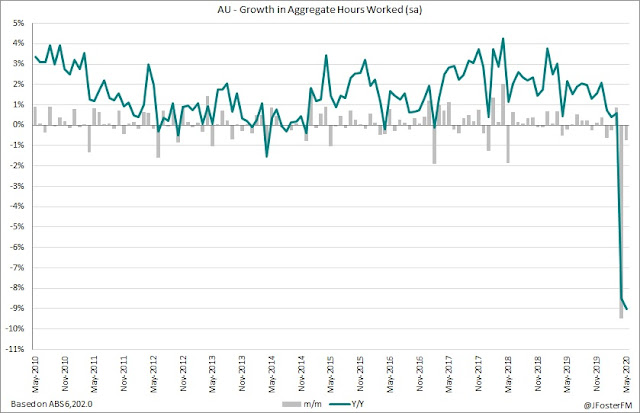Labour Force Survey — May | By the numbers
- Net employment fell by 227.7k (seasonally adjusted) in May vs -78.8k expected. In April, employment was revised to show a larger fall of 607.4k compared to -594.3k reported initially.
- National unemployment rate hit its highest level in more than 18 years at 7.1%, up from 6.4% in April (revised higher from 6.2%) and above the 6.9% level expected.
- The underutilisation rate lifted 0.1ppt to 20.2%, though underemployment eased to 13.1% from 13.8%.
- Participation rate fell from 63.6% to 62.9% — its lowest level since 2001.
- Aggregate hours worked weakened by 0.9% in May, steepening the annual decline to -9.0% from 8.5%.
Labour Force Survey — May | The details
The COVID-19 pandemic unleashed further significant damage on the labour market with almost 228k jobs being lost in May. This comes on top of the 607k jobs that were shed in April. We continue to see a tremendous flow of workers coming out of the labour force with the participation rate falling by another 0.7ppt to 62.9% to be down by more than 3 percentage points from its level in March. This reflects both the relaxation of the mutual obligation requirement linked with the JobSeeker support payment and also that firms in many industries simply would not be in a position to consider either hiring or re-hiring at this point. While the unemployment rate surged up to 7.1% from 6.4%, it is being mechanically held down by the rollover in workforce participation.
The COVID-19 pandemic unleashed further significant damage on the labour market with almost 228k jobs being lost in May. This comes on top of the 607k jobs that were shed in April. We continue to see a tremendous flow of workers coming out of the labour force with the participation rate falling by another 0.7ppt to 62.9% to be down by more than 3 percentage points from its level in March. This reflects both the relaxation of the mutual obligation requirement linked with the JobSeeker support payment and also that firms in many industries simply would not be in a position to consider either hiring or re-hiring at this point. While the unemployment rate surged up to 7.1% from 6.4%, it is being mechanically held down by the rollover in workforce participation.
Less sensitive to changes in workforce participation are the measures of underemployment and underutilisation. Underemployment moved down its record high of 13.8% to 13.1%, suggesting that some had received more hours in the month, though underutilisation ticked up a little to 20.2% to its most elevated level in the history of the series.
The disruption to labour market activity from actions taken to contain the pandemic is best reflected by the hours worked measure. After collapsing by 9.5% in April, aggregate hours worked fell by a further 0.7% in May. Compared to a year earlier, hours worked in the Australian economy are down by 9.0%. The RBA is forecasting a decline in hours worked of around 10% over the first half of 2020 and that is broadly in line with what has been reported in these data over the past two months.
Labour Force Survey — May | Insights
May's report was significantly weaker than expectations for both the employment (-227.7k vs -78.8k) and unemployment outcomes (7.1% vs 6.9%). With the JobKeeper and enhanced and relaxed JobSeeker supports in place and with the hours worked measure having declined further, underlying conditions in the labour market deteriorated further in May and the nation is now undoubtedly facing its most severe economic crisis certainly since the early 1990s recession and possibly since the 1930s. The situation will demand nothing short of ongoing fiscal and monetary support as well as a policy reform agenda to revive productivity and drive economic growth forward. Based on the sequential improvement shown in the ABS's payrolls data, the worst is now potentially behind us but it will be a long road ahead.
May's report was significantly weaker than expectations for both the employment (-227.7k vs -78.8k) and unemployment outcomes (7.1% vs 6.9%). With the JobKeeper and enhanced and relaxed JobSeeker supports in place and with the hours worked measure having declined further, underlying conditions in the labour market deteriorated further in May and the nation is now undoubtedly facing its most severe economic crisis certainly since the early 1990s recession and possibly since the 1930s. The situation will demand nothing short of ongoing fiscal and monetary support as well as a policy reform agenda to revive productivity and drive economic growth forward. Based on the sequential improvement shown in the ABS's payrolls data, the worst is now potentially behind us but it will be a long road ahead.





